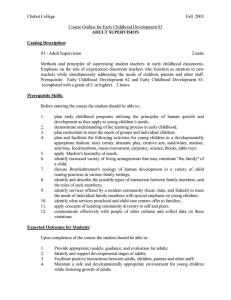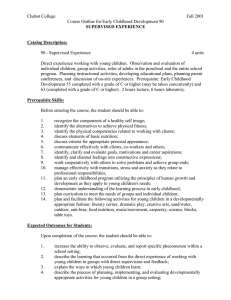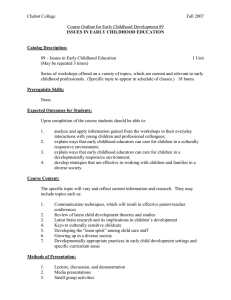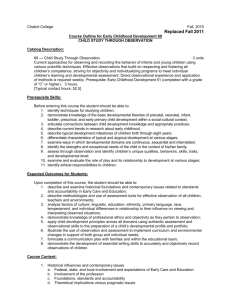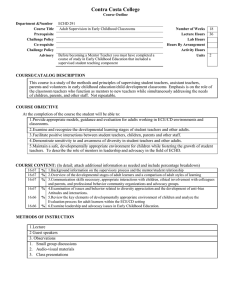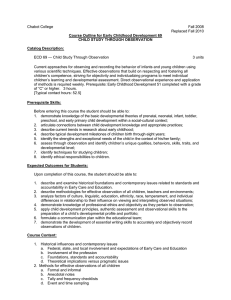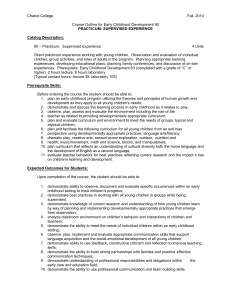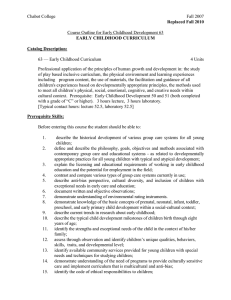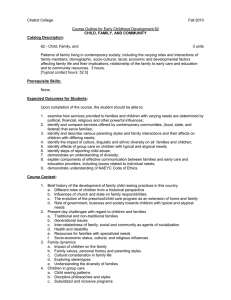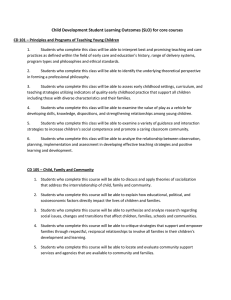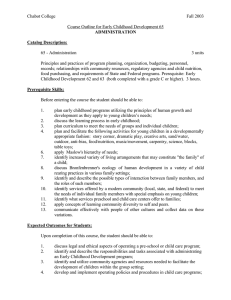Chabot College Fall, 2010 Course Outline for Early Childhood Development 64
advertisement
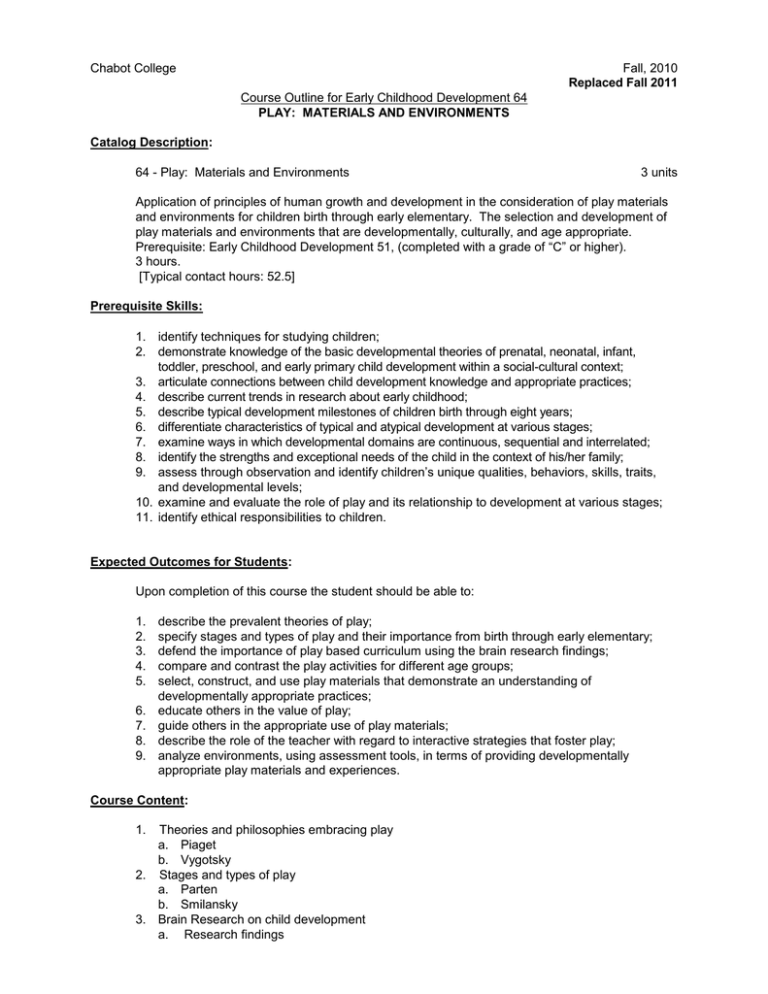
Chabot College Fall, 2010 Replaced Fall 2011 Course Outline for Early Childhood Development 64 PLAY: MATERIALS AND ENVIRONMENTS Catalog Description: 64 - Play: Materials and Environments 3 units Application of principles of human growth and development in the consideration of play materials and environments for children birth through early elementary. The selection and development of play materials and environments that are developmentally, culturally, and age appropriate. Prerequisite: Early Childhood Development 51, (completed with a grade of “C” or higher). 3 hours. [Typical contact hours: 52.5] Prerequisite Skills: 1. identify techniques for studying children; 2. demonstrate knowledge of the basic developmental theories of prenatal, neonatal, infant, toddler, preschool, and early primary child development within a social-cultural context; 3. articulate connections between child development knowledge and appropriate practices; 4. describe current trends in research about early childhood; 5. describe typical development milestones of children birth through eight years; 6. differentiate characteristics of typical and atypical development at various stages; 7. examine ways in which developmental domains are continuous, sequential and interrelated; 8. identify the strengths and exceptional needs of the child in the context of his/her family; 9. assess through observation and identify children’s unique qualities, behaviors, skills, traits, and developmental levels; 10. examine and evaluate the role of play and its relationship to development at various stages; 11. identify ethical responsibilities to children. Expected Outcomes for Students: Upon completion of this course the student should be able to: 1. 2. 3. 4. 5. 6. 7. 8. 9. describe the prevalent theories of play; specify stages and types of play and their importance from birth through early elementary; defend the importance of play based curriculum using the brain research findings; compare and contrast the play activities for different age groups; select, construct, and use play materials that demonstrate an understanding of developmentally appropriate practices; educate others in the value of play; guide others in the appropriate use of play materials; describe the role of the teacher with regard to interactive strategies that foster play; analyze environments, using assessment tools, in terms of providing developmentally appropriate play materials and experiences. Course Content: 1. Theories and philosophies embracing play a. Piaget b. Vygotsky 2. Stages and types of play a. Parten b. Smilansky 3. Brain Research on child development a. Research findings Chabot College Course Outline for Early Childhood Development 64, Page 2 Fall, 2010 4. 5. 6. 7. 8. 9. b. Implications for play c. Findings regarding language development and literacy Social and content differences of play related to age and development a. Infant/toddler play b. Preschool age children’s play c. School age children’s play Criteria for making and selecting play materials a. Age based choices b. Teacher chosen to enhance children’s competencies c. Focused on an individual’s identified needs Articulation of play benefits to other adults a. Families b. Co-workers and directors c. Community d. Policy makers The role of teachers in setting up the environment to foster appropriate play a. Special arrangements that facilitates implementation of program and curricular goals b. Aesthetic considerations that enable children to feel secure and accepted c. Shows appreciation for diversity including cultural considerations d. Adapt environment to meet needs of children with differing needs e. Safety issues Interactive strategies of the teacher to enhance children’s play a. Observation b. Planning c. Implementation 1) Provide supportive materials 2) Enrich theme areas 3) Support child initiated play d. Verbalize for the child what is observed Authentic observation and assessment of children’s play a. Reflection of child’s developmental level b. Guide for decision making regarding the building of curriculum Methods of Presentation: 1. 2. 3. 4. Lecture and discussion Media presentations Child observations Class and individual projects Assignments and Methods of Evaluating Student Progress: 1. Typical Assignments a. In your group you will construct play materials for children which are developmentally appropriate (math games, matching game, puzzles, etc.). Your project will be presented to the class along with your written report. 2. Using the criteria that the class developed on how to evaluate children’s toys, you will evaluate 5 commercial toys and write a written report on your findings a. You are to conduct two observations of a child during different time periods. Your first observation will be during free playtime and the second observation will be during a teacher directed activity. In your paper compare what you observed during these two different time periods and how the child responded. Reflect on the child’s creativity, frustration level, verbal communication, body language, etc. How were they the same and or different? 3. Methods of Evaluating Student Progress Chabot College Course Outline for Early Childhood Development 64, Page 3 Fall, 2010 a. b. c. d. Midterm Child observations Projects and other assignments Final Examination Textbook(s)(Typical): Planning Play at the Center of the Curriculum, VanHoorn, J, Monighan ,Nourot,. Merrill Prentice Hall, 2007. Play and Child Development, Joe Frost, Sue Wortham, and Sturat Riefel. Merrill Prentice Hall 2008. Special Student Materials: None. ECD 64, revised 9/09: cs
